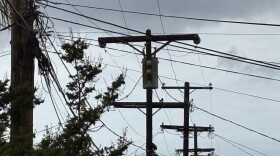San Diego State University’s architect, Bob Schulz, recently told the San Diego Union-Tribune the school must expand into Mission Valley because “there’s no room left for significant growth.” But annual filings with the state call that into question.
Public universities in California report to the legislature every year on just how efficiently they use their classrooms. The state wants them full of students at least 75 percent of the time, from 8 a.m. to 10 p.m. Monday through Friday. SDSU’s most recent figures come in below that benchmark and below what the California State University system reports overall.
Schulz pointed out the reporting guidelines were created in the 1970s and don’t reflect the reality of today.
“You’re talking pre-biotechnology, pre-nanotechnology, pre-modern engineering, pre-materials engineering, pre-computer science, pre-cloud, pretty much pre-modern world,” he said. “And it was back in the day when the California State University was very much thought to be a teachers’ college.”
He said students today aren’t just sitting in classrooms, they’re assisting with research outside of class, and that takes up more space.
“The state model assumes a classroom hour is the only hour that matters. We don’t operate that way,” Schulz said. He said the university does not measure facility use for the way it does operate.
The calculations it sends to the state are based on class hours laid out in the course catalog. They’re reported as a percentage of the state benchmark — having facilities in use three-quarters of the time. If facilities are used 75 percent of the time, the university gets a 100 percent score.
In the fall of 2016, the most recent period for which data is available, the university scored 86.6 percent out of 100 for overall classroom use. The CSU system scored 89 percent. The filings show the university met the goal in its large lecture halls, but not in smaller spaces.
Both SDSU and the CSU exceeded the goal for laboratory space, which squares with the university’s plans for SDSU West, the proposed expansion in Mission Valley. It would focus more the on the school’s research endeavors than undergraduate instruction.
The campus may also have additional space needs when construction is finished. Developer JMI Realty estimated the project would take 15 years.
Last year, the Legislative Analyst’s Office told lawmakers none of the state’s public universities currently need to expand past their existing footprints, citing their facility use filings. It suggested they expand summer enrollment. Both systems have also been working to graduate their students faster to help with enrollment capacity.
In its report, the LAO also pointed out CSU campuses are not meant for research under the California Master Plan for Higher Education, but rather bachelor’s and master’s degrees in the liberal arts. This suggests it would also not recommend an expansion to add research capacity. (The master plan is the same document that lays out the facility use guidelines Schulz called outdated.)
Despite the LAO’s recommendations, SDSU does not need the state’s permission to grow. It just needs voters on its side in November, when SDSU West will be on the ballot, along with SoccerCity.






